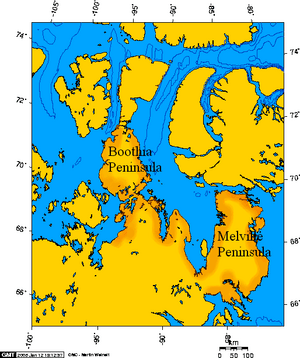Chantrey Inlet facts for kids
Chantrey Inlet (also known as Tariunnuaq in the Inuit language) is a large bay located on the Arctic coast of Canada. It is found in the northern part of Nunavut, a territory in Canada. This inlet is like a big "corner" where the coastline changes direction from going east-west to sharply north.
Chantrey Inlet is about 100 miles (160 kilometers) long. At its widest point, which is its mouth, it measures about 50 miles (80 kilometers) across.
Contents
Where is Chantrey Inlet?
Chantrey Inlet is surrounded by interesting landforms. To its west, you will find the Adelaide Peninsula. To the east, it is bordered by the mainland.
King William Island is a large island that helps protect the inlet from the northwest. The mouth of Chantrey Inlet is marked by two points: Point Ogle on the west side and Cape Britannia on the east side.
Rivers and Islands
Several rivers flow into Chantrey Inlet. The Back River is one of the main rivers that enters the inlet from the south. Near the mouth of the Back River, there is a weather station located on the Hayes River.
Inside the inlet itself, you can find Montreal Island. This island adds to the unique geography of the area.
History and People
For a long time, Chantrey Inlet has been the traditional home of the Utkuhiksalik people. They are a group of Inuit who are known as "the people of the place where there is soapstone".
Traditional Life
The Utkuhiksalik people were nomadic, meaning they moved around with the seasons. In the cold winter months, they lived in snowhouses, which are also known as igloos. During the warmer summer, they used tents for shelter.
Their diet mainly consisted of fish like trout (lake trout and Arctic char) and whitefish. They also hunted caribou, which was a very important food source for them.
European Explorers
European explorers also visited Chantrey Inlet. In 1834, George Back traveled along the Back River until he reached its mouth at Chantrey Inlet. He then explored the inlet itself.
Later, in 1839, two other explorers named Peter Warren Dease and Thomas Simpson reached Chantrey Inlet. They arrived by sailing along the coast from the west.
Chantrey Inlet Today
Today, Chantrey Inlet is a place that attracts sportsmen. People often travel there by chartered bushplane, which is a small aircraft, to enjoy fishing in its waters. It remains an important natural area in the Canadian Arctic.


